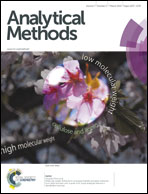Simultaneous voltammetric determination of aspartame and acesulfame-K in food products using an anodically pretreated boron-doped diamond electrode†
Abstract
A simple, rapid, and low-cost electroanalytical method is reported for the simultaneous determination of aspartame (AS) and acesulfame-K (AK) in food products. This method involves coupling differential pulse voltammetry (DPV) with an anodically pretreated boron-doped diamond (AP-BDD) electrode and 0.30 mol L−1 H2SO4 as the supporting electrolyte. A separation of the oxidation peak potentials of AS and AK greater than 500 mV was attained and the detection limits obtained for their simultaneous determination were 1.60 μmol L−1 (for AS) and 280 μmol L−1 (for AK). The proposed DPV method was successfully applied in the simultaneous determination of the sweeteners in three types of commercial food products; in the case of AS, the obtained results are similar at 95% confidence level to those obtained using a reference HPLC method. The proposed method is of great analytical interest, as it yields detection limits that are lower than those attained by the only other electroanalytical method proposed in the literature.


 Please wait while we load your content...
Please wait while we load your content...